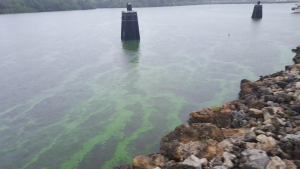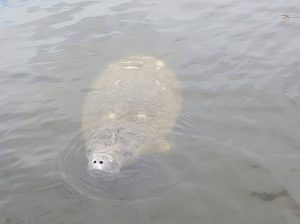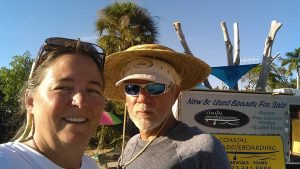Posted December 14, 2016
By NYAH TENNELL
On June 29, 2016, as a result of the increased number of toxic algal blooms along the Treasure Coast, Florida Gov., Rick Scott issued Executive Order 16-155, declaring a state of emergency in Martin and St. Lucie Counties, and called for the “comprehensive” and “emergency” management of Lake Okeechobee discharge.
According to Scott’s executive order, federal administrations have failed to properly budget for the restoration and rehabilitation of Lake Okeechobee’s surrounding 143-mile Herbert Hoover dike; and consequently, the aging structure is extremely vulnerable to leaking and failure. In order to avoid the dike’s destruction, U.S. Army Corps has been forced to dump excess freshwater from the Lake into the St. Lucie Canal, which leads to the St. Lucie Estuary, a supposed saltwater system.
These high lake levels can be attributed to excess water brought by El Nino rains, accompanied by agricultural dumping into Lake Okeechobee, which effectively led to the draining of fresh, nutrient-rich Lake Okeechobee water into the Estuary, said James Sullivan, research professor in phytoplankton dynamics at Florida Atlantic University’s Harbor Branch Oceanographic Institute.
The release of this nutrient-rich freshwater into the Estuary and increasingly warm temperatures have made way for the conditions needed for the growth of the toxic algae, Microcystin, a genus of freshwater cyanobacteria that can also exists in estuarine and marine waters.
“It’s the perfect storm for an already complex problem,” said Sullivan.
According to the Environmental Protection Agency, microcystin is almost always toxic to organisms, and is considered a hepatotoxin, meaning that it damages the liver, and can affect the kidney and reproductive system.
“We have seen extremely high levels of microcystin in the affected areas, which has been shown to cause gastrointestinal disorders and liver problems,” said Professor Larry Brand of the University of Miami’s department of marine biology and ecology.
“This is why we certainly don’t want consumers eating anything from the Estuary.”

Toxic microcystin algae overtakes waterways along the Treasure Coast in Stuart, Fla. (Photo courtesy of Dan Neumann).
The International Agency for Research in Cancer, a division of the World Health Organization based in Lyon, France, has determined that Microcystin, in its most toxic form, is possibly carcinogenic to humans, based on data suggesting Microcystin may promote tumors.
“In the southern lagoon over the summer (but not now), airborne toxins from the microcystis bloom were thousands of times above CDC levels for safety,” said Kathleen Hill, administration and communications director for the Indian River Lagoon National Estuary Program.
“There was a definite health risk, but it was associated with the immediate vicinity of the waterfront, and when the bloom was at its peak, most people avoided the area.”
According to Sullivan, when microcystin hits salt estuaries at 50 parts per thousand, a commonly used measure of salinity, algae cells should dissipate.
However, with an extremely high influx of the microcystin and its unique nature and survival methods, the toxic algae is avoiding salt water by thriving in the upper column of salt-water estuaries where freshwater is present.
This is possible due to the fact that saltwater is more dense than freshwater, causing the available freshwater in the St. Lucie Estuary to sit at the surface of the water, while saltwater “sinks,” existing in the lower columns of the water.
Consequently, the microcystin gains access to sunlight and plenty of nutrient-rich freshwater by blanketing the top of the water while limiting other species’ available sunlight and oxygen.
“Although a number of diverse species will be affected by the toxins, I am currently concerned about bigger marine animals, like manatees and dolphins, who breathe at the surface,” said Sullivan.

A manatee faintly covered in algae was spotted at the surface of the St. Lucie Estuary (Photo courtesy of Dan Neumann).
Hill also mentioned that the Indian River Lagoon Council was extremely concerned about what the huge influx of freshwater being released into the estuary would do to filter feeders, such as oysters.
“Oysters can survive short periods in freshwater, but prefer saltier waters to really thrive. The releases to the estuary went on for about 180 days, and there were billions of gallons released. However, recent surveys are showing that salinity along the bottom of the estuary stayed, apparently, just salty enough for oysters to survive. The folks at Florida Oceanographic Coastal Center were more than a little surprised to discover live, adult oysters still alive on the bottom,” Hill stated.
Unfortunately, microcystin is not the only toxin that has scientists and citizens worried about the algae’s potential environmental and health effects.
Professor Larry Brand also noted the discovery of the neurotoxin, BMAA (beta-methylamino-l-alanine) in the Indian River Lagoon, which is produced by cyanobacteria.
Neurotoxins are poisonous to nerve tissue, and “the toxin BMAA is suspected to be linked to degenerative diseases, like Dementia, Parkinson’s, and Alzheimer’s,” said Brand.
Although advisories and warnings have been issued, it is difficult to thoroughly evaluate the extent of the current hazard and potential consequences due to limitations in government support and available human study subjects.
“What we are witnessing is slow and chronic exposure to Microcystin and BMAA, in which we may not see certain effects for 10 years or so,” said Sullivan.
“Because the methods and technology used to detect BMAA are extremely expensive, it is difficult to get research efforts funded, which is why there isn’t enough hard research and evidence available,” he added.
So what are residents of the Treasure Coast expected to do in response to the harmful air and water quality in the multitude of areas being impacted by the algae?
St. Lucie County resident, Gianfranco Lamarra, an avid fisherman and boater, said that he hasn’t been on the water and months, and has been hit tremendously by the toxic health scare.
“Not only do I fish for fun, but fishing is how I feed my family,” Lamarra said.
For the past six years, Lamarra has spent almost every weekend on the water, playing catch and release with small baitfish, and taking in the larger game fish, like snook and mangrove snapper, to cook and eat for dinner.
“I don’t know when it will be safe to eat from the lagoon again,” said Lamarra. “I haven’t even been boating because the algae stinks, like sewer waste, and leaves boats in bad condition when they sit in the infested waters for extended periods.”

Dan and Rochelle Neumann, Owners of Coastal Paddle Boarding, announce relocation to Cortez, Florida as “bitter-sweet, said Dan Neumann (Photo courtesy of Dan Neumann).
In response to the algae blooms and the subsequent loss of business, Dan and Rochelle Neumann, owners of Coastal Paddle Boarding, have shut down their location in Stuart, and have relocated their business to Ana Maria Island in Cortez, off of Florida’s west coast.
Once the county health department posted signs that read, “Avoid contact with the water,” I figured that it might be time to start over, said Dan Neumann.
“The loses are monumental. We’re down at least $100,000 this year alone,” he added.
Ultimately, over the next few years, we will be able to better assess the economic, financial and health impact of the toxic algae blooms, as all the damage has not yet been done.
